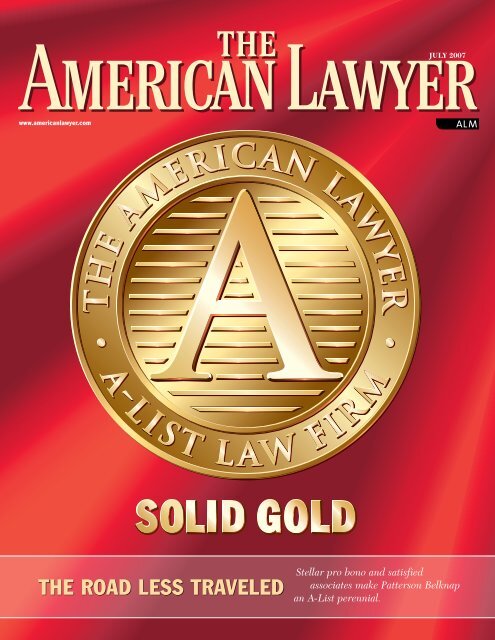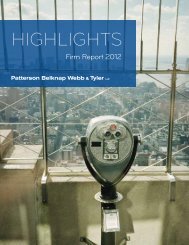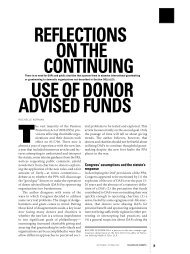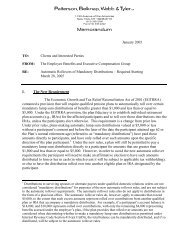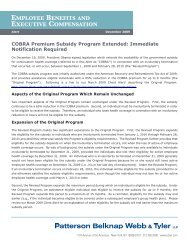THE ROAD LESS TRAVELED - Patterson Belknap Webb & Tyler LLP
THE ROAD LESS TRAVELED - Patterson Belknap Webb & Tyler LLP
THE ROAD LESS TRAVELED - Patterson Belknap Webb & Tyler LLP
Create successful ePaper yourself
Turn your PDF publications into a flip-book with our unique Google optimized e-Paper software.
JULY 2007<br />
www.americanlawyer.com<br />
The Road Less Traveled<br />
Stellar pro bono and satisfied<br />
associates make <strong>Patterson</strong> <strong>Belknap</strong><br />
an A-List perennial.
Stellar pro bono and satisfied<br />
associates make <strong>Patterson</strong> <strong>Belknap</strong><br />
an A-List perennial.<br />
The Road Less Traveled<br />
By Ross Todd<br />
<strong>Patterson</strong> <strong>Belknap</strong> <strong>Webb</strong> & <strong>Tyler</strong><br />
Lawyer Head Count* 171<br />
I l l u s t r a t i o n b y G e r a r d H u e r t a<br />
isa Cleary is pure kinetic energy.<br />
The <strong>Patterson</strong> <strong>Belknap</strong> <strong>Webb</strong> & <strong>Tyler</strong> partner<br />
spins in her desk chair to retrieve a document<br />
from her office shelves. She whirls back with a checklist<br />
in hand. The list has about 50 specific categories—taking and<br />
defending depositions, working on a preliminary injunction<br />
hearing, and so on—and either Cleary or the other assigning<br />
partner in <strong>Patterson</strong>’s litigation department will complete one<br />
for each of the firm’s 70-plus litigation associates. Twice a year,<br />
associates sit down with an assigning partner for about an hour<br />
to run through the list and set out their goals: <strong>Patterson</strong> partners<br />
say that associates who chart their own development are<br />
more likely to be happy associates. This particular checklist is<br />
scribbled with Cleary’s notes tracking an associate’s progress.<br />
“These are things we would like every associate to have the opportunity<br />
to do over time,” says Cleary, who in addition to assigning<br />
cases and counseling associates manages a full caseload<br />
of her own.<br />
And did we mention that she also heads <strong>Patterson</strong>’s pro<br />
bono efforts? Cleary matches <strong>Patterson</strong> lawyers with requests,<br />
frequently urgent, from the firm’s pro bono clients. The firm’s<br />
goal—which it has met for the last three years—is to get every<br />
one of its lawyers to participate in pro bono work.<br />
Her list of responsibilities puts Cleary at the fulcrum of the<br />
successes that have made <strong>Patterson</strong> an annual presence on our<br />
A-List since its inception in 2003. Pro bono and associate satisfaction<br />
anchor <strong>Patterson</strong>’s A-list scores: The firm received 199<br />
points (out of 200) in pro bono this year; and it finished seventh<br />
in The American Lawyer’s Midlevel Associates Survey, by far<br />
the highest of any New York City firm. With 180 lawyers sharing<br />
both a single office and a dedication to the values of hard<br />
work and public service, <strong>Patterson</strong> can indulge in the luxury of<br />
Equity Partners* 59<br />
Gross Revenue $141,500,000<br />
Profits Per Partner $1,040,000<br />
Revenues Per Lawyer $825,000<br />
Total Pro Bono Hours 20,407<br />
Average Pro Bono Hours per Attorney 119.34<br />
Percentage of Attorneys with<br />
More than 20 Hours<br />
91.81<br />
Top clients include: Johnson & Johnson, Abbott Laboratories, Dow Jones & Company, Inc.,<br />
Rockefeller Brothers Fund, United States Tennis Association.<br />
*Am Law 200 numbers. Firm now has 180 lawyers and 60 partners.<br />
an extensive pro bono program and intensive professional development<br />
training for associates.<br />
Still, great pro bono and happy associates don’t necessarily<br />
add up to high revenues. This year <strong>Patterson</strong>’s revenue per lawyer<br />
grew only from $820,000 to $825,000—knocking the firm’s<br />
RPL score from 169 to 157. <strong>Patterson</strong>’s profits per partner actually<br />
took a step back, dropping from $1.135 to $1.04 million.<br />
The A-List isn’t just a report card on firm statistics. It’s a<br />
measure of how well firms balance moneymaking with the priorities<br />
of service and collegiality that used to distinguish the legal<br />
profession. <strong>Patterson</strong> partners recognize that it’s a delicate<br />
balance. “The biggest challenge for us is economic, because<br />
competition for business is fierce,” says outgoing managing<br />
partner Rochelle Korman, a partner in the firm’s tax-exempt<br />
practice. “But we also don’t want to become a sweatshop.”<br />
The firm has tweaked its formula in the past: <strong>Patterson</strong>
weathered a rocky financial phase in the<br />
early 1990s, even going so far as considering<br />
a merger. But partners say the firm now<br />
has a solid base of litigation clients—notably<br />
Johnson & Johnson, Abbott Laboratories,<br />
and Dow Jones & Company, Inc.—and one<br />
of the nation’s most prominent tax-exempt<br />
organization practices, representing The<br />
Frick Collection, the Rockefeller Brothers<br />
Fund, and the United States Tennis Association,<br />
among others. To hold onto its spot<br />
on The A-List, the firm has to compete with<br />
1,000-lawyer megafirms for business without<br />
sacrificing pro bono hours or associate satisfaction.<br />
Thus far <strong>Patterson</strong> partners have<br />
been able to pull it off, but they know that<br />
maintaining their place will take constant<br />
attention to detail.<br />
Cleary, a wispy 49-year-old with<br />
short-cropped dark hair, says she learned<br />
values by watching her parents. Her mother,<br />
who worked at Duke University’s medical<br />
center, and her father, a teacher and coach,<br />
were always opening their home to people<br />
in need, she says. “My parents taught me<br />
that life is short; you’ll be remembered for<br />
the good you’ve done,” says Cleary, one of<br />
eight siblings.<br />
With Cleary heading the firm’s pro bono<br />
program, <strong>Patterson</strong> has achieved a memorable<br />
feat: Not only has every lawyer at the firm<br />
engaged in pro bono or public service in every<br />
year since 2004, all partners have participated<br />
going back to 2002. The firm averaged almost<br />
120 pro bono hours per lawyer last year, with<br />
more than 90 percent of the firm’s attorneys<br />
spending at least 20 hours on pro bono work.<br />
Lateral partner candidates are informed that<br />
they will do pro bono if they join <strong>Patterson</strong><br />
<strong>Belknap</strong>. Cleary points to the commitment<br />
of <strong>Patterson</strong>’s leadership as the root of the<br />
firm’s successful pro bono program: Cochair<br />
Robert LoBue, for instance, drafted U.S. Supreme<br />
Court amicus briefs for Human Rights<br />
First in detainee rights cases; and litigation<br />
head Paul Gardephe is preparing to argue<br />
a pro bono Supreme Court case this fall, on<br />
behalf of parents who want New York City to<br />
pay for the private school education of their<br />
disabled child.<br />
Cleary says that <strong>Patterson</strong>’s manageable<br />
size helps her move fast to accept assignments<br />
and get pro bono work to the firm’s<br />
lawyers. “It’s easier for me as chair of the<br />
pro bono committee to deal with a smaller<br />
number of [lawyers],” she says. Cleary<br />
fields the rounds of weekly and monthly e-<br />
mail requests from pro bono clients such as<br />
The Legal Aid Society of New York, New<br />
York Lawyers for the Public Interest, MFY<br />
Legal Services, Inc., and Lawyers Alliance<br />
for New York, and quickly passes cases along<br />
to <strong>Patterson</strong> lawyers in need of a pro bono<br />
project. Pro bono clients say they appreciate<br />
that responsiveness. “If you send [Lisa] a list<br />
of pro bono cases, <strong>Patterson</strong> runs a conflicts<br />
check and they say yes immediately,” says<br />
Lynn Kelly, executive director of MFY Legal<br />
Services, an independent, not-for-profit law<br />
firm representing low-income New Yorkers.<br />
When <strong>Patterson</strong> put together a focus group<br />
to discuss client service last fall, MFY’s Kelly<br />
was included in a panel with in-house lawyers<br />
for Fortune 500 clients. “That was a sign<br />
of how important pro bono work is to the<br />
firm,” Kelly says. “I felt very valued.”<br />
Keeping Score<br />
<strong>Patterson</strong> builds on pro bono excellence.<br />
$1,000,000<br />
$800,000<br />
$600,000<br />
$400,000<br />
$200,000<br />
0<br />
5<br />
4<br />
3<br />
2<br />
1<br />
0<br />
rpl<br />
2005 2006<br />
associate<br />
satisfaction<br />
Score<br />
2005 2006<br />
120<br />
100<br />
200<br />
150<br />
100<br />
While <strong>Patterson</strong> lawyers have taken on<br />
high-profile Guantánamo Bay detainee<br />
briefs and death penalty cases outside New<br />
York, the firm’s efforts center on helping<br />
indigent New Yorkers. <strong>Patterson</strong> has an ongoing<br />
relationship, for instance, with Metropolitan<br />
Hospital Center in East Harlem<br />
through Volunteers of Legal Service. Partners<br />
Peter Tomlinson and Gloria Phares take<br />
referrals directly from a nurse practitioner<br />
and a social worker who identify patients<br />
with legal problems that contribute to their<br />
health problems. Last year the firm helped<br />
25 families with 62 children through the program.<br />
“They may not be the most glamorous<br />
80<br />
60<br />
40<br />
20<br />
0<br />
50<br />
pro bono<br />
Score<br />
0<br />
2005 2006<br />
diversity<br />
Rank<br />
2005 2006<br />
cases in the world, but we’re helping, family<br />
by family,” Cleary says. The firm also takes<br />
on locally based impact litigation. Cleary and<br />
a team of associates put in three years and<br />
thousands of hours on behalf of a group of<br />
17 disabled men living in an adult home in<br />
Queens, in a case that MFY brought to the<br />
firm. <strong>Patterson</strong> filed a suit alleging that the<br />
men had been subjected to unnecessary<br />
prostate surgery, naming the home, its operator,<br />
a home health agency, a hospital, and<br />
two doctors. The case partially settled in July<br />
2004: Plaintiffs found new housing and received<br />
$433,000 each.<br />
<strong>Patterson</strong>’s pro bono is also a way for<br />
the firm to attract and retain associates. “[Pro<br />
bono] is an important reflection of who the<br />
firm is,” says one associate. With 250 nonbillable<br />
hours included in the 2,100 hours expected<br />
of associates, young lawyers have leeway<br />
to take on pro bono cases—and they’re<br />
pushed to do so. One associate says the<br />
phone calls from pro bono committee members<br />
started soon after his arrival at the firm<br />
in the fall, and picked up at an even higher<br />
volume in November as the annual deadline<br />
to log pro bono hours approached. “People<br />
come here in part because they want to do<br />
[pro bono],” says associate Amin Kassam.<br />
Satisfied associates are the other reason<br />
for <strong>Patterson</strong>’s perennial appearance on The<br />
A-list: This year the firm rose four places in<br />
the midlevel associate survey, to seventh<br />
place from eleventh—an accomplishment all<br />
the more admirable when you consider that<br />
the next-highest New York City firm (Weil,<br />
Gotshal & Manges) ranked thirty-eighth.<br />
Associates say the firm’s manageable size allows<br />
them to work closely with even the most<br />
prominent <strong>Patterson</strong> partners. They also say<br />
that since the firm staffs matters leanly, they<br />
get to do substantive work.<br />
“Every day I am talking to clients,” says<br />
one associate. “At <strong>Patterson</strong>, associates learn<br />
to think the way partners think,” says another,<br />
who has handled depositions solo against<br />
partners from other firms. “You have work<br />
that you are accountable for.” More than half<br />
of <strong>Patterson</strong>’s associates are litigators who,<br />
as at any litigation-heavy firm, face a lot of<br />
document review (despite the small cadre of<br />
staff attorneys who handle part of the load).<br />
But partner Robert Lehrburger, head of<br />
the firm’s associate and clerk recruiting efforts,<br />
says <strong>Patterson</strong> attempts to moderate<br />
drudgery with substantive work. “There’s<br />
an emphasis here on pushing responsibility<br />
down,” he says.<br />
Although the responsibility keeps associates<br />
comparatively satisfied, the firm is still
P h o t o g r a p h s b y C h r i s M u e l l e r<br />
Carrying a heavy load:<br />
Pro bono chief and litigation<br />
assigning partner Lisa Cleary
tinkering with the details of professional development.<br />
Working with Cleary and other<br />
litigation partners, for instance, director of<br />
professional development Robin Klum overhauled<br />
the department’s mentoring program<br />
last year. Previously, associates were paired<br />
with a partner on day one at the firm. “We<br />
went to lunch the first day, and that was it,”<br />
says partner Tomlinson, who joined <strong>Patterson</strong><br />
as an associate in 1996. Under the new<br />
program, initiated in May 2006, associates<br />
choose their own mentors after six months<br />
at the firm. They’re also broken into class<br />
groups and paired with teams of three partners.<br />
One such group recently met with former<br />
firm chair Gregory Diskant and partners<br />
Clay Pierce and Sarah Zgliniec for Chinese<br />
food at Diskant’s apartment. The dinner gave<br />
way to a lesson in expert witness questioning<br />
techniques. Pierce and Zgliniec acted as the<br />
experts, and star litigator Diskant, a professorial<br />
type with salt-and-pepper hair and a<br />
wide grin, critiqued the associates. “It was<br />
really useful getting partners’ feedback,” says<br />
one associate of the exercise. “We all know<br />
how good Greg [Diskant] is at trial.”<br />
Cochair William Cavanaugh, Jr. (left) and<br />
former chair Gregory Diskant: Balancing<br />
values and profits.<br />
While the changes in mentoring are<br />
meant to improve associate satisfaction, the<br />
firm is adjusting its associate bonus structure<br />
to boost performance in another A-List category:<br />
revenue per lawyer. This year, for the<br />
first time, <strong>Patterson</strong> will tie annual associate<br />
bonuses to billable hours. “It’s fair to say the<br />
new bonus structure is in part a response<br />
to revenue pressure,” says cochair William<br />
Cavanaugh, Jr., speaking in his distinct<br />
Long Island accent. Revenue per lawyer is<br />
<strong>Patterson</strong>’s A-List weakness: This year its<br />
RPL grew only from $820,000 to $825,000,<br />
dropping the firm from thirty-second to<br />
forty-fourth among Am Law 200 firms, and<br />
nineteenth of the 30 Am Law 200 firms<br />
based in New York, where average RPL<br />
was $990,000. The firm’s profits per partner,<br />
which are not a factor in The A-List rankings,<br />
dropped this year, from $1.135 to $1.04<br />
million. (Litigation head Gardephe and cochair<br />
LoBue attribute the PPP drop to a<br />
downturn in the cycle of <strong>Patterson</strong>’s patent<br />
litigation.) In April the firm announced that<br />
associates who don’t hit 2007 targets of 1,850<br />
billable and 2,100 total hours will receive<br />
only 75 percent of the market rate bonus;<br />
in 2008 they will get only half. “We’re still a<br />
profit-maximizing organization,” says cochair<br />
Cavanaugh. He reminds <strong>Patterson</strong> partners<br />
and associates that to continue to compete<br />
for work and laterals, the firm can’t afford to<br />
be pigeonholed as a lifestyle shop. “It’s not so<br />
much who you attract as who you might miss<br />
out on,” he says pointing to litigation head<br />
Gardephe, a former Time Inc. deputy general<br />
counsel and U.S. Department of Justice<br />
official, as a lateral who might have passed
on a firm with that reputation.<br />
Despite this year’s dip in financial returns,<br />
<strong>Patterson</strong>’s numbers have actually<br />
improved dramatically over the last decade.<br />
From 1998 to 2005, <strong>Patterson</strong>’s PPP grew<br />
141 percent, from $470,000 to $1.135 million—almost<br />
twice the 72 percent average<br />
growth rate of firms in The Am Law 200.<br />
During the same period, the firm’s RPL<br />
grew by 66 percent—from $495,000 to<br />
$820,000—beating the Am Law 200 average<br />
RPL growth rate of 48 percent.<br />
A major reason for <strong>Patterson</strong>’s growth was<br />
the firm’s move in the early 1990s into highstakes<br />
patent litigation, a decision spearheaded<br />
by Diskant, Cavanaugh, and former partner<br />
David Dobbins (he is now of counsel).<br />
The patent litigation practice began when<br />
the firm took on a few important medical device<br />
cases for a subsidiary of longtime firm<br />
client Johnson & Johnson. It has since grown<br />
to one-third of the firm’s litigation docket,<br />
with a blue-chip client list that includes J&J,<br />
General Electric Company, Abbott Laboratories,<br />
and Siemens AG.<br />
With high-end work, <strong>Patterson</strong> made a<br />
move to charge high-end rates in 2002—a<br />
move that met with some initial resistance.<br />
“We had to convince our partners and our<br />
clients that we are not the low-cost alternative,”<br />
says firm cochair LoBue. “We’re not<br />
the cheap firm; we’re the good firm.”<br />
<strong>Patterson</strong>’s determination to improve its<br />
financials was really a fight to stay a small,<br />
independent firm with a traditional partnership.<br />
“[Money] is not the key driver for people<br />
here,” says outgoing managing partner<br />
Korman. “But you need to be financially successful<br />
to do all the other things we consider<br />
intrinsically important to the firm.”<br />
In the early 1990s, lagging financial performance<br />
put the partnership in jeopardy.<br />
From 1990 to 1992, <strong>Patterson</strong>’s head count<br />
fell from 143 to 107 lawyers—and its revenues<br />
dropped almost 20 percent, from<br />
$49 million to $40 million. At the urging of<br />
consultants, <strong>Patterson</strong> explored the merger<br />
market. The firm entered preliminary talks<br />
with about eight firms, and exchanged financial<br />
information with Philadelphia’s Pepper<br />
Hamilton after meetings in 1990 and 1991.<br />
Ultimately <strong>Patterson</strong>’s partners opted to<br />
stay independent. Says veteran litigation<br />
partner Philip Forlenza: “When the profession<br />
changed, particularly in the early 1990s,<br />
a lot of firms did one of two things. There<br />
were those who couldn’t or didn’t change—<br />
collegial firms that didn’t make it. Other<br />
firms that made the change, that really professionalized<br />
business management, were<br />
nothing like what they were. We were able<br />
to steer a middle course—to become more<br />
businesslike and a little less chaotically democratic.”<br />
The firm had already taken such<br />
steps as hiring an executive director, Marvin<br />
Brittman, to help manage finances and<br />
administration, and appointing tax-exempt<br />
organization partner Antonia Grumbach to<br />
be <strong>Patterson</strong>’s first managing partner. “This<br />
was one of those nice old places where you<br />
would bill a client once or twice a year,” says<br />
Grumbach with a chuckle. As she and Brittman<br />
took over day-to-day management in<br />
the 1990s, bills started going out more regularly.<br />
Now cochair LoBue kicks off biweekly<br />
partner meetings by highlighting new business,<br />
and executive director Brittman gives<br />
a rundown of firm finances that details who<br />
has brought in what business and who is<br />
heading up major matters.<br />
At the same time, though, <strong>Patterson</strong><br />
maintained the traditions of its partnership.<br />
Partner lunches and dinners are scheduled<br />
twice a month—and two-thirds of the 60<br />
partners actually turn out for them. A weekly<br />
newsletter called “the pink sheet” goes<br />
out firmwide every Friday to highlight new<br />
business, firm anniversaries, and pro bono<br />
victories. (Some partners mourn that the<br />
firm is forgoing the distribution of actual<br />
pink sheets of paper in favor of digital distribution<br />
as a part of firm cost-cutting and<br />
environmental efforts.) And the firm intentionally<br />
keeps the ratio of highest-to-lowest<br />
paid partner at a relatively low 4:1—a number<br />
that has barely budged from its 1988<br />
level of 3:1. “We look around at these [profits]<br />
and think, ‘We’re blessed. It’s fabulous,’<br />
” says partner Forlenza, who remembers<br />
the firm’s troubled years. “If things were a<br />
little less fabulous, that would be fine.”<br />
Diversity, says cochair LoBue, is one<br />
of the values that <strong>Patterson</strong> is determined to<br />
maintain. “We have to make this workplace<br />
inviting to everyone,” he says. “This is not<br />
just about altruism, but the health of the<br />
firm,” particularly in an era in which clients<br />
demand a commitment to diversity. <strong>Patterson</strong><br />
had two African American office managing<br />
partners in the 1980s—Richard Parsons<br />
(now the chairman and CEO of Time Warner<br />
Inc.) in New York and Togo West, Jr.,<br />
in the firm’s since-closed Washington, D.C.,<br />
office—but after West’s departure, it did not<br />
have a partner of color for more than a decade.<br />
That changed only when litigator Karla<br />
Sanchez, who now heads the firm’s diversity<br />
committee, made partner in 2004; a second<br />
minority partner, former New Jersey attorney<br />
general Peter Harvey, joined the firm<br />
in March 2006, after a five-year courtship<br />
by <strong>Patterson</strong>.<br />
The firm has had more success with diversity<br />
in the associate ranks. Minorities make<br />
up 14.1 percent of all lawyers at <strong>Patterson</strong>,<br />
placing the firm thirty-ninth in Minority Law<br />
Journal’s Diversity Scorecard. (By comparison,<br />
Wachtell, Lipton, Rosen & Katz, a similar-size<br />
New York City firm, reported 10.6<br />
percent minority attorneys, ranking 103rd.)<br />
<strong>Patterson</strong> has been successful at hiring minority<br />
associates from clerkships but last year<br />
expanded its law school recruiting to the University<br />
of Texas, Northwestern University, and<br />
Georgetown University Law Center—which<br />
have relatively higher percentages of minority<br />
students than the schools where the firm has<br />
traditionally recruited.<br />
<strong>Patterson</strong> also launched a firmwide diversity<br />
study in May, initiated by Sanchez’s<br />
diversity committee. Consultants from Eastern<br />
Point Consulting Group, Inc., based in<br />
Newton, Massachusetts, conducted 14 focus<br />
groups and about 15 individual interviews<br />
to assess the firm’s diversity efforts. (Before<br />
it reports, Eastern Point will also speak with<br />
several minority associates who left the firm.)<br />
The hope, says executive director Brittman,<br />
is that the consultants’ findings will lead to<br />
more focused diversity training than the firm<br />
has previously had.<br />
Firms like <strong>Patterson</strong> are becoming rarer.<br />
As many of <strong>Patterson</strong>’s midsize colleagues<br />
have merged, grown, or dissolved, this shop<br />
has proudly worn the dinosaur label hung on it<br />
by consultants for nearly two decades. And it’s<br />
in no hurry to shrug it off. Says former chair<br />
Diskant: “I’m fine with being a dinosaur.”<br />
E-mail: rtodd@alm.com.<br />
Reprinted with permission from the JULY 2007 edition of The<br />
American Lawyer. Cover is altered from original published<br />
version. © 2007 ALM Properties, Inc. All rights reserved. Further<br />
duplication without permission is prohibited. For information, contact<br />
212.545.6111 or visit www.almreprints.com. #001-07-07-0008 www.pbwt.com


